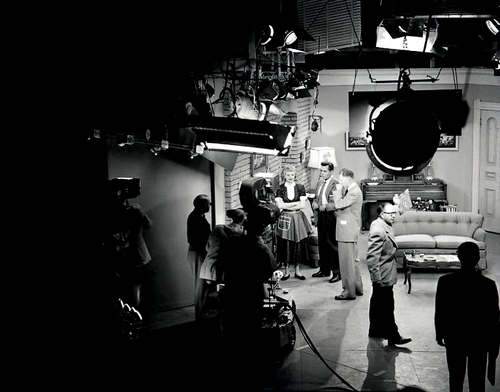In my “Sightings” column for today’s Wall Street Journal, I take a look at what network TV was like in 1951, and find that it hasn’t really changed all that much. Here’s an excerpt.
* * *
In present-tense culture, golden anniversaries tend to get swept away by the whirlwind of current events. Here’s an example: Network television as we know it came into being on Sept. 4, 1951, when AT&T threw the switch on the first transcontinental coaxial cable. Up to that time, TV had been an essentially regional phenomenon. The most important network shows were all performed live in New York, and the only way for West Coast viewers to see them was for fuzzy-looking film copies called “kinescopes” to be shipped to Los Angeles and broadcast a week later. The coaxial cable changed that by making it possible to transmit live video signals from coast to coast–in both directions. Within a matter of months, Hollywood had become a major center of TV production.
Don’t be embarrassed if you didn’t know any of this. So far as I know, no one has taken note of the golden anniversary of the coaxial cable, or celebrated the fiftieth birthdays of three influential series that the cable made possible. But if you owned a TV set in 1951, you might well remember these Truman-era debuts:
 • Oct. 15, 1951: “I Love Lucy,” the first Hollywood-based sitcom to be shot on film with three cameras in front of a live studio audience. Lucille Ball’s zany antics soon made it the most popular show on the air. At a time when there were only 15 million TV sets in America, 11 million families watched “I Love Lucy” every Monday night.
• Oct. 15, 1951: “I Love Lucy,” the first Hollywood-based sitcom to be shot on film with three cameras in front of a live studio audience. Lucille Ball’s zany antics soon made it the most popular show on the air. At a time when there were only 15 million TV sets in America, 11 million families watched “I Love Lucy” every Monday night.
• Nov. 18, 1951: “See It Now,” the first TV newsmagazine, whose first episode opened with a shot of two control-room monitors. One showed a live picture of the Statue of Liberty, the other a live picture of the Golden Gate Bridge. Edward R. Murrow, the host, was visibly impressed: “For the first time, man has been able to sit at home and look at two oceans at the same time.” It may sound quaint now, but 60 years ago that image took people’s breaths away.
• Dec. 16, 1951: “Dragnet,” the first filmed crime drama to make extensive use of location shooting. When Jack Webb opened each episode by saying “This is the city,” he meant Los Angeles, not a cramped TV studio somewhere in midtown Manhattan–and that’s what you saw on the small screen.
Sound familiar? It should–just as it did in 1951. Not only did “See It Now,” “I Love Lucy” and “Dragnet” originate on radio, but they’re still being imitated….
* * *
Read the whole thing here.
The opening sequence of the first episode of See It Now:
“The Human Bomb,” the first episode of Dragnet, directed by Jack Webb, written by James E. Moser, and starring Webb, Barton Yarborough, and Raymond Burr:
Terry Teachout on the arts in New York City
An ArtsJournal Blog
